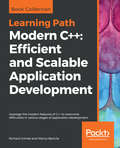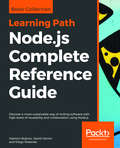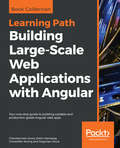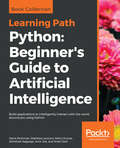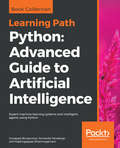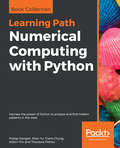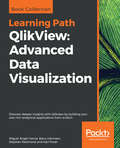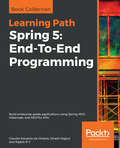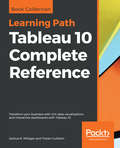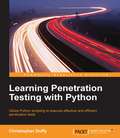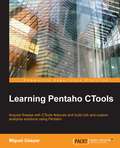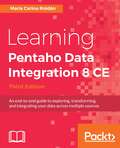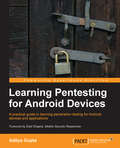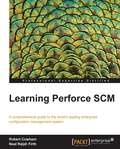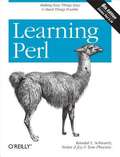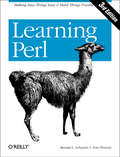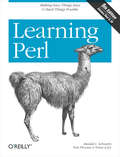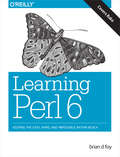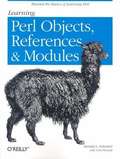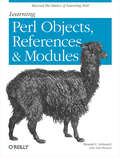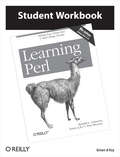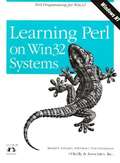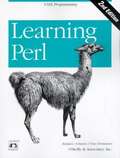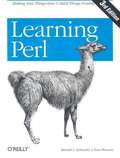- Table View
- List View
Learning Path - Modern C++: Efficient and Scalable Application Development
by Richard Grimes Marius BancilaThis Learning Path is designed for developers who want to gain a solid foundation with C++. A computer, an Internet connection, and the desire to learn how to code in C++ are all you need to get started with this Learning Path.
Learning Path - Node.js Complete Reference Guide: Discover A More Sustainable Way Of Writing Software With High Levels Of Reusability And Collaboration Using Node. Js
by David Herron Valentin Bojinov Diogo ResendeNode.js Complete Reference Guide is designed for web developers who have a rudimentary understanding of JavaScript and web application development, are keen to enrich their development skills to create RESTful applications, and want utilize their skills to build microservices.
Learning Path - Professional Web Development with Angular: Your One-stop Guide To Building Scalable And Production-grade Angular Web Apps
by Chandermani Arora Kevin Hennessy Christoffer Noring Doguhan UlucaThis Learning Path is designed for JavaScript and frontend developers who want to get a comprehensive practical experience on using Angular for end-to-end enterprise-ready applications.
Learning Path - Python: Beginner's Guide to Artificial Intelligence
by Sebastian Raschka Giancarlo Zaccone Md. Rezaul Karim Vahid Mirjalili Denis RothmanThis Learning Path is for anyone who wants to understand the fundamentals of Artificial Intelligence and implement it practically by devising smart solutions. You will learn to extend your machine learning and deep learning knowledge by creating practical AI smart solutions. Prior experience with Python and statistical knowledge is essential to make the most out of this Learning Path.
Learning Path - Python: Expert Machine Learning Systems And Intelligent Agents Using Python
by Armando Fandango Giuseppe Bonaccorso Rajalingappaa ShanmugamaniThis Learning Path is for data scientists, machine learning engineers, artificial intelligence engineers who want to delve into complex machine learning algorithms, calibrate models, and improve the predictions of the trained model. You will encounter the advanced intricacies and complex use cases of deep learning and AI. A basic knowledge of programming in Python and some understanding of machine learning concepts are required to get the best out of this Learning Path.
Learning Path - Python: Harness The Power Of Python To Analyze And Find Hidden Patterns In The Data
by Pratap Dangeti Allen Yu Claire Chung Aldrin Yim Theodore PetrouIf you want to learn how to use the many libraries of Python to extract impactful information from your data and present it as engaging visuals, then this is the ideal Learning Path for you. Some basic knowledge of Python is enough to get started with this Learning Path.
Learning Path - QlikView: Advanced Data Visualization
by Miguel Angel Garcia Barry Harmsen Stephen Redmond Karl PoverThis Learning Path is designed for developers who want to go beyond their technical knowledge of QlikView and understand how to create analysis and data visualizations that solve real business needs. To grasp the concepts explained in this Learning Path, you should have a basic understanding of the common QlikView functions and some hands-on experience with the tool.
Learning Path - Spring 5: End to End Programming
by Rajesh R V Dinesh Rajput Claudio Eduardo OliveiraIf you're a developer starting out with Spring, then this learning path will help you learn about the new Spring 5.0 framework concepts followed by their implementation in Java and Kotlin. If you are an experienced Spring developer, then this Learning Path will enable you to gain insights into the new features added in Spring 5.0.
Learning Path – Getting Started with Tableau 10: Transform Your Business With Rich Data Visualizations And Interactive Dashboards With Tableau 10
by Donabel Santos Joshua MilliganGetting Started with Tableau 10 is designed for business intelligence users and data analysts who want to expand their data visualization knowledge by learning Tableau 10.
Learning Penetration Testing with Python
by Christopher DuffyUtilize Python scripting to execute effective and efficient penetration tests About This Book * Understand how and where Python scripts meet the need for penetration testing * Familiarise yourself with the process of highlighting a specific methodology to exploit an environment to fetch critical data * Develop your Python and penetration testing skills with real-world examples Who This Book Is For If you are a security professional or researcher, with knowledge of different operating systems and a conceptual idea of penetration testing, and you would like to grow your knowledge in Python, then this book is ideal for you. What You Will Learn * Familiarise yourself with the generation of Metasploit resource files * Use the Metasploit Remote Procedure Call (MSFRPC) to automate exploit generation and execution * Use Python's Scrapy, network, socket, office, Nmap libraries, and custom modules * Parse Microsoft Office spreadsheets and eXtensible Markup Language (XML) data files * Write buffer overflows and reverse Metasploit modules to expand capabilities * Exploit Remote File Inclusion (RFI) to gain administrative access to systems with Python and other scripting languages * Crack an organization's Internet perimeter * Chain exploits to gain deeper access to an organization's resources * Interact with web services with Python In Detail Python is a powerful new-age scripting platform that allows you to build exploits, evaluate services, automate, and link solutions with ease. Python is a multi-paradigm programming language well suited to both object-oriented application development as well as functional design patterns. Because of the power and flexibility offered by it, Python has become one of the most popular languages used for penetration testing. This book highlights how you can evaluate an organization methodically and realistically. Specific tradecraft and techniques are covered that show you exactly when and where industry tools can and should be used and when Python fits a need that proprietary and open source solutions do not. Initial methodology, and Python fundamentals are established and then built on. Specific examples are created with vulnerable system images, which are available to the community to test scripts, techniques, and exploits. This book walks you through real-world penetration testing challenges and how Python can help. From start to finish, the book takes you through how to create Python scripts that meet relative needs that can be adapted to particular situations. As chapters progress, the script examples explain new concepts to enhance your foundational knowledge, culminating with you being able to build multi-threaded security tools, link security tools together, automate reports, create custom exploits, and expand Metasploit modules. Style and approach This book is a practical guide that will help you become better penetration testers and/or Python security tool developers. Each chapter builds on concepts and tradecraft using detailed examples in test environments that you can simulate.
Learning Pentaho CTools
by Miguel GasparAcquire finesse with CTools features and build rich and custom analytics solutions using Pentaho About This Book * Learn everything you need to know to make the most of CTools * Create interactive and remarkable dashboards using the CTools * Understand how to use and create data visualizations that can make the difference * The author of our book works for Pentaho as a Senior Consultant * Acts as a follow-up to Packt's previously published products on Pentaho such as Pentaho Business Analytics Cookbook, Pentaho Analytics for MongoDB, Pentaho Data Integration Cookbook - Second Edition, and Pentaho Reporting [Video] * Our book is based on the latest version of Pentaho, that is, 6.0 Who This Book Is For If you are a CTools developer and would like to expand your knowledge and create attractive dashboards and frameworks, this book is the go-to-guide for you. A basic knowledge of JavaScript and Cascading Style Sheets (CSS) is highly recommended. What You Will Learn * Install Community Tools on Pentaho; and understand the necessary concepts and considerations when creating an exciting dashboard design * Get data from many different Pentaho datasources and deliver it in different formats (CSV, XLS, XML, or JSON) * Use the Community Data Access (CDA) as the data abstraction layer and understand the concepts in the Community Dashboard Framework (CDF) * Create a Community Dashboard Editor (CDE) dashboard and make the most of the main components * Create and make use of widgets and use duplicate components to have data-driven sections on the dashboard * Customize and create interaction between all components, including charts, using the Community Charts Components * Create and embed dashboards in a better and new way * Create plugins and make use of parameters inside Pentaho without writing code In Detail Pentaho and CTools are two of the fastest and most rapidly growing tools for practical solutions not found in any other tool available on the market. Using Pentaho allows you to build a complete analytics solution, and CTools brings an advanced flexibility to customizing them in a remarkable way. CTools provides its users with the ability to utilize Web technologies and data visualization concepts, and make the most of best practices to create a huge visual impact. The book starts with the basics of the framework and how to get data to your dashboards. We'll take you all the way through to create your custom and advanced dashboards that will create an effective visual impact and provide the best user experience. You will be given deep insights into the lifecycle of dashboards and the working of various components. Further, you will create a custom dashboard using the Community Dashboards Editor and use datasources to load data on the components. You will also create custom content using Query, the Freeform Addins Popup, and text components. Next, you will make use of widgets to create similar sections and duplicate components to reproduce other components on a dashboard. You will then learn to build a plugin without writing Java code, use Sparkl as a CPK plugin manager, and understand the application of deployment and version control to dashboard development. Finally, you will learn tips and tricks that can be very useful while embedding dashboards into other applications. This guide is an invaluable tutorial if you are planning to use custom and advanced dashboards among the solutions that you are building with Pentaho. Style and approach This book is a pragmatic, easy-to-follow guide that provides theoretical concepts, ideas, and tricks to better understand the necessary theoretical concepts. It also provides you with a set of highly intriguing samples of dashboards with customized code within them that can be utilized for future projects.
Learning Pentaho Data Integration 8 CE - Third Edition
by Maria Carina RoldanGet up and running with the Pentaho Data Integration tool using this hands-on, easy-to-read guide About This Book • Manipulate your data by exploring, transforming, validating, and integrating it using Pentaho Data Integration 8 CE • A comprehensive guide exploring the features of Pentaho Data Integration 8 CE • Connect to any database engine, explore the databases, and perform all kind of operations on relational databases Who This Book Is For This book is a must-have for software developers, business intelligence analysts, IT students, or anyone involved or interested in developing ETL solutions. If you plan on using Pentaho Data Integration for doing any data manipulation task, this book will help you as well. This book is also a good starting point for data warehouse designers, architects, or anyone who is responsible for data warehouse projects and needs to load data into them. What You Will Learn • Explore the features and capabilities of Pentaho Data Integration 8 Community Edition • Install and get started with PDI • Learn the ins and outs of Spoon, the graphical designer tool • Learn to get data from all kind of data sources, such as plain files, Excel spreadsheets, databases, and XML files • Use Pentaho Data Integration to perform CRUD (create, read, update, and delete) operations on relationaldatabases • Populate a data mart with Pentaho Data Integration • Use Pentaho Data Integration to organize files and folders, run daily processes, deal with errors, and more In Detail Pentaho Data Integration(PDI) is an intuitive and graphical environment packed with drag-and-drop design and powerful Extract-Tranform-Load (ETL) capabilities. This book shows and explains the new interactive features of Spoon, the revamped look and feel, and the newest features of the tool including transformations and jobs Executors and the invaluable Metadata Injection capability. We begin with the installation of PDI software and then move on to cover all the key PDI concepts. Each of the chapter introduces new features, enabling you to gradually get practicing with the tool. First, you will learn to do all kind of data manipulation and work with simple plain files. Then, the book teaches you how you can work with relational databases inside PDI. Moreover, you will be given a primer on data warehouse concepts and you will learn how to load data in a data warehouse. During the course of this book, you will be familiarized with its intuitive, graphical and drag-and-drop design environment. By the end of this book, you will learn everything you need to know in order to meet your data manipulation requirements. Besides, your will be given best practices and advises for designing and deploying your projects. Style and approach Step by step guide filled with practical, real world scenarios and examples.
Learning Pentesting for Android Devices
by Aditya GuptaThis is an easy-to-follow guide, full of hands-on and real-world examples of applications. Each of the vulnerabilities discussed in the book is accompanied with the practical approach to the vulnerability, and the underlying security issue. This book is intended for all those who are looking to get started in Android security or Android application penetration testing. You don't need to be an Android developer to learn from this book, but it is highly recommended that developers have some experience in order to learn how to create secure applications for Android.
Learning Perforce SCM
by Neal Ralph Firth Robert CowhamLearning Perforce SCM is written in a friendly and practical style with a focus on getting you started with Perforce efficiently and effectively. The book provides plenty of examples and screenshots to guide you through the process of learning."Learning Perforce SCM" is for anyone who wants to know how to adeptly manage software development activities using Perforce. Experience with other version control tools is a plus but is not required.
Learning Perl
by Randal L. Schwartz Tom Phoenix Brian D FoyIf you're just getting started with Perl, this is the book you want--whether you're a programmer, system administrator, or web hacker. Nicknamed "the Llama" by two generations of users, this bestseller closely follows the popular introductory Perl course taught by the authors since 1991. This 6th edition covers recent changes to the language up to version 5.14. Perl is suitable for almost any task on almost any platform, from short fixes to complete web applications. Learning Perl teaches you the basics and shows you how to write programs up to 128 lines long--roughly the size of 90% of the Perl programs in use today. Each chapter includes exercises to help you practice what you've just learned. Other books may teach you to program in Perl, but this book will turn you into a Perl programmer. Topics include: Perl data and variable types Subroutines File operations Regular expressions String manipulation (including Unicode) Lists and sorting Process management Smart matching Use of third party modules
Learning Perl
by Randal L. Schwartz Tom PhoenixIf you ask Perl programmers today what book they relied on most when they were learning Perl, you'll find that an overwhelming majority will name Learning Perl--also known affectionately as "the Llama." The first edition of Learning Perl appeared in 1993 and has been a bestseller ever since. Written by two of the most prominent and active members of the Perl community, this book is the quintessential tutorial for the Perl programming language.Perl began as a tool for Unix system administrators, used for countless small tasks throughout the workday. It has since blossomed into a full-featured programming language on practically every computing platform, and is used for web programming, database manipulation, XML processing, and (of course) system administration--all this while still remaining the perfect tool for the small daily tasks it was designed for. Perl is quick, fun, and eminently useful. Many people start using Perl because they need it, but they continue to use Perl because they love it.The third edition of Learning Perl has not only been updated for Perl 5.6, but has also been rewritten from the ground up to reflect the needs of programmers learning Perl today. Informed by their years of success at teaching Perl as consultants, the authors have re-engineered the book to better match the pace and scope appropriate for readers trying to get started with Perl, while retaining the detailed discussion, thorough examples, and eclectic wit for which the book is famous.This edition of the Llama includes an expanded and more gently-paced introduction to regular expressions, new exercises and solutions designed so readers can practice what they've learned while it's still fresh in their minds, and an overall reworking to bring Learning Perl into the new millennium.Perl is a language for getting your job done. Other books may teach you to program in Perl, but this book will turn you into a Perl programmer.
Learning Perl (In a Nutshell)
by Randal L. Schwartz Tom Phoenix Brian D FoyLearning Perl, popularly known as "the Llama," is the book most programmers rely on to get started with Perl. The bestselling Perl tutorial since it was first published in 1993, this new fifth edition covers recent changes to the language up to Perl 5.10. This book reflects the combined experience of its authors, who have taught Perl at Stonehenge Consulting since 1991. Years of classroom testing and experience helped shape the book's pace and scope, and this edition is packed with exercises that let you practice the concepts while you follow the text. Topics include:Perl data & variable typesSubroutinesFile operationsRegular expressionsString manipulationLists & sortingProcess managementSmart matchingUsing third party modulesPerl is the language for people who want to get work done. Originally targeted to sysadmins for heavy-duty text processing, Perl is now a full-featured programming language suitable for almost any task on almost any platform-from short fixes on the command line to web applications, bioinformatics, finance, and much more. Other books may teach you to program in Perl, but this book will turn you into a Perl programmer.
Learning Perl 6: Keeping the Easy, Hard, and Impossible Within Reach
by Brian D Foyf you’re ready to get started with Raku (formerly Perl 6), this is the book you want, whether you’re a programmer, system administrator, or web hacker. Raku is a new language—a modern reinvention of Perl suitable for almost any task, from short fixes to complete web applications. This hands-on tutorial gets you started.Author brian d foy (Mastering Perl) provides a sophisticated introduction to this new programming language. Each chapter in this guide contains exercises to help you practice what you learn as you learn it. Other books may teach you to program in Raku, but this book will turn you into a Raku programmer.Learn how to work with:Numbers, strings, blocks, and positionalsFiles and directories and input/outputAssociatives, subroutines, classes, and rolesJunctions and setsRegular expressions and built-in grammarsConcurrency features: Promises, supplies, and channelsControlling external programs and other advanced features
Learning Perl Objects, References & Modules
by Randal L. SchwartzLearning Perl Objects, References & Modules picks up where Learning Perl leaves off. This new book offers a gentle introduction to the world of references, object-oriented programming, and the use of Perl modules that form the backbone of any effective Perl program. Following the successful format of Learning Perl, each chapter in the book is designed to be small enough to be read in just an hour or two. Each chapter ends with a series of exercises to help you practice what you've learned with answers.
Learning Perl Objects, References, and Modules
by Randal L. Schwartz Tom PhoenixPerl is a versatile, powerful programming language used in a variety of disciplines, ranging from system administration to web programming to database manipulation. One slogan of Perl is that it makes easy things easy and hard things possible. This book is about making the leap from the easy things to the hard ones.Learning Perl Objects, References & Modules offers a gentle but thorough introduction to advanced programming in Perl. Written by the authors of the best-selling Learning Perl, this book picks up where that book left off. Topics include:Packages and namespacesReferences and scopingManipulating complex data structuresObject-oriented programmingWriting and using modulesContributing to CPANFollowing the successful format of Learning Perl, each chapter in the book is designed to be small enough to be read in just an hour or two, ending with a series of exercises to help you practice what you've learned. To use the book, you just need to be familiar with the material in Learning Perl and have ambition to go further.Perl is a different language to different people. It is a quick scripting tool for some, and a fully-featured object-oriented language for others. It is used for everything from performing quick global replacements on text files, to crunching huge, complex sets of scientific data that take weeks to process. Perl is what you make of it. But regardless of what you use Perl for, this book helps you do it more effectively, efficiently, and elegantly.Learning Perl Objects, References & Modules is about learning to use Perl as a programming language, and not just a scripting language. This is the book that separates the Perl dabbler from the Perl programmer.
Learning Perl Student Workbook
by Brian D FoyIf you’re a programmer, system administrator, or web hacker just getting started with Perl, this workbook helps you gain hands-on experience with the language right away. It’s the perfect companion to the 6th Edition of Learning Perl (known as “the Llama”), which is based on the popular introductory Perl course taught by the book’s authors since 1991.The first half of this workbook presents the exercises, with answers in the second half. The material covers Perl up to version 5.14.Topics include:Scalar DataLists and ArraysSubroutinesInput and OutputHashesRegular ExpressionsControl StructuresPerl ModulesFile TestsDirectory OperationsStrings and SortingSmart MatchingProcess ManagementSome Advanced Perl TechniquesDatabases
Learning Perl on Win32 Systems
by Tom Christiansen Erik Olson Randal L. SchwartzIn this carefully paced course, leading Perl trainers and a Windows NT practitioner teach you to program in the language that promises to emerge as the scripting language of choice on NT. Based on the "llama" book, this book features tips for PC users and new NT-specific examples, along with a foreword by Larry Wall, the creator of Perl, and Dick Hardt, the creator of Perl for Win32.
Learning Perl on Win32 Systems
by Tom Christiansen Erik Olson Randal L. SchwartzIn this smooth, carefully paced course, leading Perl trainers and a Windows NT practitioner teach you to program in the language that promises to emerge as the scripting language of choice on NT. With a foreword by Larry Wall, the creator of Perl, this book is the "official" guide for both formal (classroom) and informal learning. Based on the "llama book," Learning Perl on Win32 Systems features tips for PC users and new NT-specific examples. Perl for Win32 is a language for easily manipulating text, files, user and group profiles, performance and event logs, and registry entries, and a distribution is available on the Windows NT Resource Kit. Peer-to-peer technical support is now available on the perl.win32.users mailing list. The contents include: An introduction to "the Perl way" for Windows users A quick tutorial stroll through Perl in one lesson Systematic, topic-by-topic coverage of Perl's broad capabilities Innumerable, brief code examples Programming exercises for each topic, with fully worked-out answers Access to NT system functions through Perl Database access with Perl CGI programming with Perl Erik Olson is director of advanced technologies for Axiom Technologies, LC, where he specializes in providing Win32 development solutions. Randal L. Schwartz and Tom Christiansen have also written Programming Perl, co-authored with Larry Wall and published by O'Reilly and Associates.
Learning Perl, 2nd Edition
by Tom Christiansen Randal L. SchwartzIn this update of a bestseller, two leading Perl trainers teach you to use the most universal scripting language in the age of the World Wide Web. With a foreword by Larry Wall, the creator of Perl, this smooth, carefully paced book is the "official" guide for both formal (classroom) and informal learning. It is now current for Perl version 5.004. Learning Perl is a hands-on tutorial designed to get you writing useful Perl scripts as quickly as possible. Exercises (with complete solutions) accompany each chapter. A lengthy new chapter in this edition introduces you to CGI programming, while touching also on the use of library modules, references, and Perl's object-oriented constructs. Perl is a language for easily manipulating text, files, and processes. It comes standard on most UNIX platforms and is available free of charge on all other important operating systems. Perl technical support is informally available -- often within minutes -- from a pool of experts who monitor a USENET newsgroup (comp.lang.perl.misc) with tens of thousands of readers. Contents include: A quick tutorial stroll through Perl basics Systematic, topic-by-topic coverage of Perl's broad capabilities Lots of brief code examples Programming exercises for each topic, with fully worked-out answers How to execute system commands from your Perl program How to manage DBM databases using Perl An introduction to CGI programming for the Web
Learning Perl, 3rd Edition
by Randal L. Schwartz Tom PhoenixLearning Perlis the quintessential tutorial for the Perl programming language. The third edition has not only been updated to Perl Version 5.6, but has also been rewritten from the ground up to reflect the needs of programmers learning Perl today. Other books may teach you to program in Perl, but this book will turn you into a Perl programmer.
